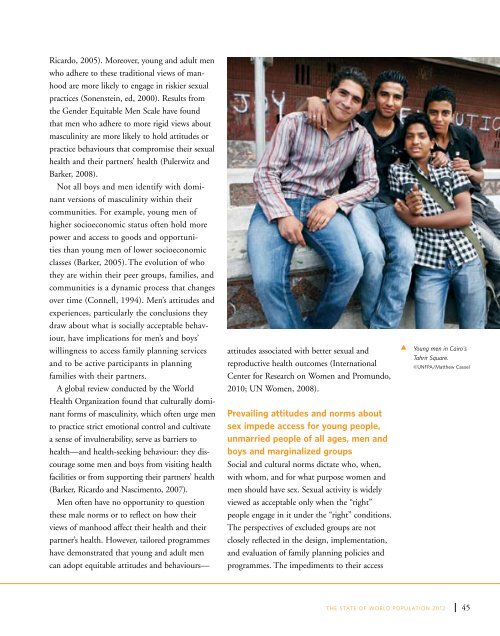State of World Population 2012 - Country Page List - UNFPA
State of World Population 2012 - Country Page List - UNFPA
State of World Population 2012 - Country Page List - UNFPA
Create successful ePaper yourself
Turn your PDF publications into a flip-book with our unique Google optimized e-Paper software.
Ricardo, 2005). Moreover, young and adult men<br />
who adhere to these traditional views <strong>of</strong> manhood<br />
are more likely to engage in riskier sexual<br />
practices (Sonenstein, ed, 2000). Results from<br />
the Gender Equitable Men Scale have found<br />
that men who adhere to more rigid views about<br />
masculinity are more likely to hold attitudes or<br />
practice behaviours that compromise their sexual<br />
health and their partners’ health (Pulerwitz and<br />
Barker, 2008).<br />
Not all boys and men identify with dominant<br />
versions <strong>of</strong> masculinity within their<br />
communities. For example, young men <strong>of</strong><br />
higher socioeconomic status <strong>of</strong>ten hold more<br />
power and access to goods and opportunities<br />
than young men <strong>of</strong> lower socioeconomic<br />
classes (Barker, 2005). The evolution <strong>of</strong> who<br />
they are within their peer groups, families, and<br />
communities is a dynamic process that changes<br />
over time (Connell, 1994). Men’s attitudes and<br />
experiences, particularly the conclusions they<br />
draw about what is socially acceptable behaviour,<br />
have implications for men’s and boys’<br />
willingness to access family planning services<br />
and to be active participants in planning<br />
families with their partners.<br />
A global review conducted by the <strong>World</strong><br />
Health Organization found that culturally dominant<br />
forms <strong>of</strong> masculinity, which <strong>of</strong>ten urge men<br />
to practice strict emotional control and cultivate<br />
a sense <strong>of</strong> invulnerability, serve as barriers to<br />
health—and health-seeking behaviour: they discourage<br />
some men and boys from visiting health<br />
facilities or from supporting their partners’ health<br />
(Barker, Ricardo and Nascimento, 2007).<br />
Men <strong>of</strong>ten have no opportunity to question<br />
these male norms or to reflect on how their<br />
views <strong>of</strong> manhood affect their health and their<br />
partner’s health. However, tailored programmes<br />
have demonstrated that young and adult men<br />
can adopt equitable attitudes and behaviours—<br />
attitudes associated with better sexual and<br />
reproductive health outcomes (International<br />
Center for Research on Women and Promundo,<br />
2010; UN Women, 2008).<br />
Prevailing attitudes and norms about<br />
sex impede access for young people,<br />
unmarried people <strong>of</strong> all ages, men and<br />
boys and marginalized groups<br />
Social and cultural norms dictate who, when,<br />
with whom, and for what purpose women and<br />
men should have sex. Sexual activity is widely<br />
viewed as acceptable only when the “right”<br />
people engage in it under the “right” conditions.<br />
The perspectives <strong>of</strong> excluded groups are not<br />
closely reflected in the design, implementation,<br />
and evaluation <strong>of</strong> family planning policies and<br />
programmes. The impediments to their access<br />
t<br />
Young men in Cairo's<br />
Tahrir Square.<br />
©<strong>UNFPA</strong>/Matthew Cassel<br />
THE STATE OF WORLD POPULATION <strong>2012</strong><br />
45
















